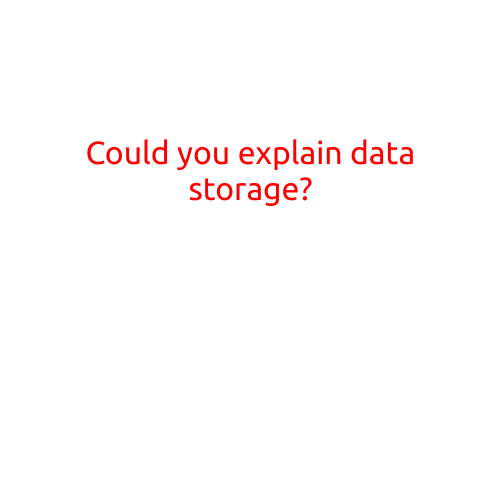
Could you explain data storage?
In today’s digital age, data is all around us. From the information stored on our personal devices to the vast amounts of data collected by companies and governments, it’s amazing to think about just how much information is being generated and stored every second. But have you ever stopped to think about how all of this data is actually stored?
What is data storage?
Data storage refers to the process of saving and storing data electronically, often on computer systems, servers, or external devices. This data can take many forms, including text documents, images, videos, audio files, and even large datasets used for scientific research or business analysis.
Types of Data Storage
There are several types of data storage, each with its own unique characteristics and uses. Some of the most common include:
- HDD (Hard Disk Drive): A traditional type of data storage that uses physical disks and magnetic heads to read and write data. HDDs are commonly used in desktop computers and laptops.
- SSD (Solid-State Drive): A faster and more modern type of data storage that uses flash memory to store data. SSDs are often used in laptops, tablets, and smartphones.
- Cloud Storage: A type of data storage that stores data online, accessible through the internet. Cloud storage services like Google Drive, Dropbox, and Microsoft OneDrive allow users to store and share files remotely.
- Flash Drive: A small, portable device that uses flash memory to store data. Flash drives are often used to transfer files between devices or to store small amounts of data.
- Database: A special type of data storage that uses software to organize and manage large amounts of data. Databases are commonly used in business and scientific applications.
Data Storage Considerations
When it comes to data storage, several factors need to be considered, including:
- Capacity: How much data can be stored?
- Speed: How quickly can data be accessed and transferred?
- Security: How protected is the data from unauthorized access or tampering?
- Scalability: Can the data storage system grow and adapt as data needs change?
- Durability: How well can the data storage system withstand physical or environmental stresses?
Benefits of Data Storage
Data storage offers many benefits, including:
- Improved Efficiency: Quickly access and manage large amounts of data to streamline business processes or research projects.
- Increased Security: Protect sensitive data from unauthorized access or theft.
- Cost Savings: Reduce the need for physical storage space and minimize the risk of data loss.
- Flexibility: Access data from anywhere, at any time, using cloud storage or mobile devices.
- Backups: Ensure that critical data is easily recoverable in the event of a disaster or system failure.
Conclusion
Data storage is a vital component of modern computing, allowing us to create, store, and access large amounts of information. By understanding the different types of data storage and the factors that influence storage options, individuals and organizations can make informed decisions about how to store their data safely and efficiently. Whether you’re a personal user or a business owner, data storage is an essential aspect of the digital age.





